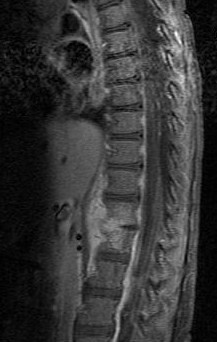Discitis
This article needs additional citations for verification. (April 2020) |
| Discitis | |
|---|---|
 | |
| Discitis in a 2 year old child. | |
| Specialty | Rheumatology |
Discitis, or diskitis, is an
Description
Discitis is an
Signs and symptoms
Symptoms include severe back pain, leading to lack of mobility. In adults, it can lead to severe consequences, such as sepsis or epidural abscess, but it can also spontaneously resolve, especially in children under 8 years of age. Discitis occurs post-surgically in approximately 1–2 percent of patients after spinal surgery. Some very young children may refuse to walk[3] and arching of the back is possible. In post-operative situations, the symptoms occur within a week and result in severe low back pain or neck pain (depending on the surgical location).
If untreated, the discitis may resolve on its own, causing spontaneous fusion of the intervertebral disc space, cause a chronic low grade infection, or progress to osteomyelitis and possibly even an epidural abscess. In case of concomitant inflammation of one or more vertebrae (in such cases usually involving the areas adjacent to the intervertebral disc spaces)[4] the condition is called spondylodiscitis.
Causes
There is debate as to the cause, although hematogenous seeding of the offending organism is favored as well as direct spread. Spontaneous discitis is usually from
Diagnosis

Diagnosis is usually apparent on
Treatment
Treatment usually includes antibiotics, and reducing the mobility of the affected region, either with a back brace or a plaster cast. Without treatment, the patient may form an abscess which may need to be surgically corrected.[7] Due to the poor vascularity of the disc, drugs required for treatment often include potent agents such as Ciprofloxacin along with Vancomycin. Occasionally, oral drugs can be used to treat the infection but it may fail and IV drugs may be required.
If the patient is an adult, many surgeons and doctors now recommend moving little and often and within the pain limits of the medication. Discs respond to osmotic pressure therefore movement is beneficial to increase their blood flow and fluid dynamics. In children, whether to bed rest or move a little is decided on an individual basis, depending on the site and severity of the discitis.
References
- ^ "Discitis - An Uncommon, Severe Cause of Back Pain". muschealth.org. Retrieved 2024-04-07.
- ^ Haley, Thomas; Lichten, David; Chacin, Sergio; Rankin, Robert; Mahon, David (2015). "Spinal Rehabilitation". In Maitin, Ian B.; Cruz, Ernesto (eds.). CURRENT Diagnosis & Treatment: Physical Medicine & Rehabilitation. New York, NY: McGraw-Hill Education. Retrieved 2024-03-17.
- PMID 11245515. Retrieved 2024-03-17.
- ISBN 978-3-540-69963-7.
- ISBN 9780702050473.
- PMID 15850997.
- ^ MD, Dave Harrison (2022-12-31). "Discitis: Definition, Causes, Symptoms, Diagnosis, Treatment, and Prognosis". Spine Info. Retrieved 2024-03-10.
